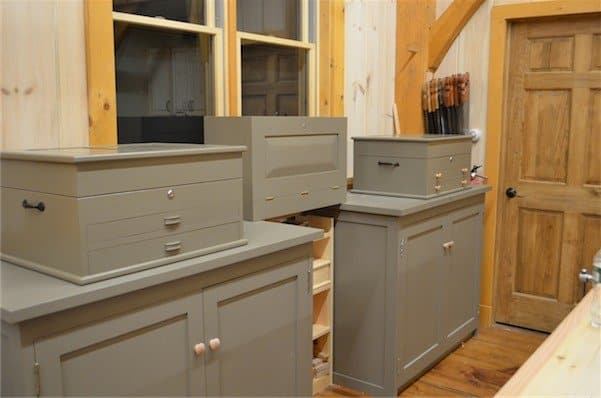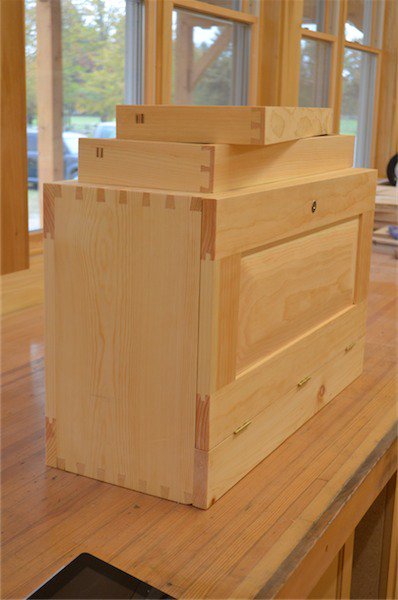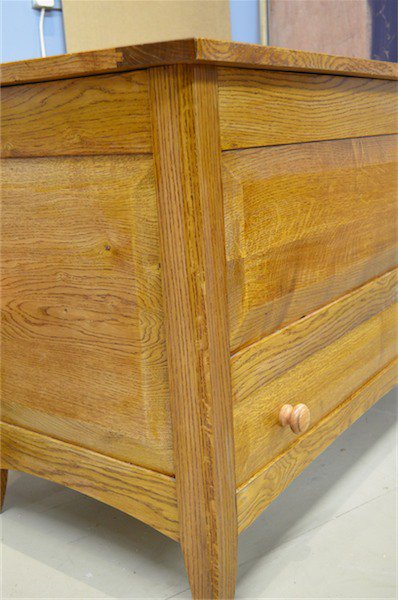Thoughts on the Joiner’s Tool Chest
I suppose I know more about tool chests and such than most people might, mostly because all the craftsmen I worked with as a teenaged apprentice used simple joiner’s tool chests and kept them beneath the end of the workbench; the same joiner’s workbench I did the YouTube video on a few months ago here. This chest comprised a rectangular box 30” long, 20” deep and 20” high. They were of course always dovetailed and at an antique shop or car boot sale (fleamarket) in the England you might find half a dozen or more. My friend Bill specializes in such pieces as well as many pine cabinets and cupboards and people buy these obsolete antiques as blanket chests and coffee tables as they have no real practical use today.
Changing culture, shifting needs

Tool box features
Inside these ancient tool chests you will always find two or three sliding tills that slid from front to back and these tills once housed small hand tools such as chisels and saw files, bullnose planes, block planes and so on. The lid is either a simple single board hinged on the back edge or the same as the ones we make in our weeklong tool chest workshops as part of our month-long series of skill-build projects. They were always pine or some other softwood without exception. Craftsmen new that the weight to strength ratio was critical. I only ever saw one made from another wood and that was poplar. In Britain they were always painted black, and mostly unfinished on the inside. I own one that I bought as youngster from an antique shop. It was made by a railway carriage maker who built the fancy mahogany and oak interiors to first class railway carriages in the earlier days of steam trains. The inside of the tool chest is lined with oak and mahogany and has some very pleasing cabinet work french polished and very lovely. I use it for my tools.
Joints, panels, tools etc

The Joints
Mortise and tenons, through dovetails, half lap dovetails and housing dadoes are featured throughout the box. These joints are my three-joint-ten-hand-tools minimalist woodworking theory I have promoted now since 1990. Can you see how critical this understanding is to the simplicity of working wood. This will be a soon-to-come online broadcast following the coffee table and the rocking chair. I am looking forward to filming this project. The coffee table and the rocking chair films are well under way so as soon as these are filmed we can hopefully get on with the Joiner’s tool chest.




I will look forward to that series. I am thinking about building the workbench now. I have an assembly table behind my table saw but not proper hand tool bench and I don’t have a bench vise.
I would like to combine your tool box with an idea for a box I have sketched up. I was wondering if you have a picture of the inside of this toolbox, it would be greatly appreciated.
I very much look forward to any video installments that you may add to your collection.
I do, but not with me. When I return to the UK next week I will dig one out.
Whoa! Let me ask a question. Does that mean that this is the norm? I would say not. I am glad that you do use these tools as I have for near fifty years now. But the point is that 99.999% don’t. I doubt that I have met anyone in the past thirty years that uses moulding planes as you say you do. That is the sadness of it. Why would anyone make a tool chest to store wooden plough planes in if they don’t have wooden plough planes or moulding planes? That’s all I am saying. I think it’s great that people are returning to the possibility of using hand tools and discovering the merits for themselves and that’s what I have been promoting for twenty years now. We are considerd dinosaurs though, even in today’s investigative era when people are seeking new and more fulfilling ways to work wood.
Paul, you make very cogent points. The way I choose to work wood isn’t the norm these days. I make 18th century reproduction furniture and, frankly, the only way to make it look right is to use the tools that were used by the original makers. But many people don’t do this, so the old style storage may not make sense for them.
The spice chest I just build for Popular Woodworking Magazine was done entirely with hand tools. The small ovolo molding at the waist was struck with a Gabriel c.1790 plane. The rest of the moldings were worked out with my full set of Gabriel c.1770 hollows and rounds. You can see it here: http://www.popularwoodworking.com/woodworking-blogs/editors-blog/why-build-a-spice-chest.
Zach, aka Your Fellow Dinosaur 🙂
Really nice work Zach.
The panels are of course inside a plowed groove in the frame. From there on they can be simply glued to the box and that’s the purpose of the frame. It allows for panel shrinkage and/or expansion within a constraining frame. I assume of course that you are talking about the joiner’s tool box and not the chest.
Gluing long grain to long grain in the same orientation means that the two glues surfaces will stay glued for, well, about two hundred years or so.
of course the front panel is hinged to that bottom rail. It’s a fall-front access box. As I pointed out in my blog, craftsmen stopped making full tool chests in the earl 1900’s because shapers (spindle moulders UK) replaced the moulding planes and plough planes and filletster planes. Scaling down meant a much lesser volume of tools and space. Two Joiner’s tool chests will hold just about all of the tools we use today.
Will you be doing one of these as part of the master classes?
Indeed we will. We will be doing both the craftsman’s tool chest and the Joiner’s toolbox, Patrick. First we will be doing the coffee table and the Craftsman style rocker though.
I’d like to see more construction details on the joiner’s tool chest myself. I’m interested in tool chests in general, and have built a couple of specialized chesta. Being able to put away my tools at then end of the day makes it easier to be organized in the shop. Otherwise I end up with tools piled everywhere.
Arrghh. I was hoping that the toolchest would be the next video project. Seems to make sense to have a place to store ones tools before moving on to many other projects. That was the project that was going to get me subscribed.
Oh well. I may have to go at it myself.
-Scott
Paul,love reading your blog and watching your videos. I have built several tool chests using bits and pieces of your designs and making changes to suit my personal preferences. Your blog and videos have also gotten me in to more traditional hand woodworking. To date I’ve built 2 roubo style benches,a Nicholson bench. As of today I have 73 wooden planes in my collection. Most I pick up at junk sales,flea markets antique shops for a couple bucks. Several I have built myself. I’m working on a 35in jointer plane as we speak,building the body out of a peice of barn beam from a 150yr old bank barn. It’s eastern hemlock. Thank you for everything you have done and continue to do for the trade.
Each professional mechanic requires tool chest for their workplace. Even if a tool is a very common thing for a garage.